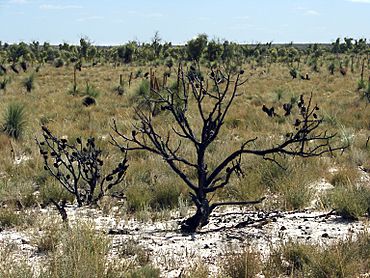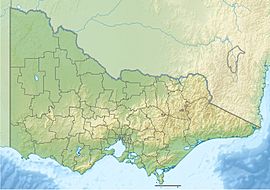Little Desert National Park facts for kids
Quick facts for kids Little Desert National ParkVictoria |
|
|---|---|
|
IUCN Category II (National Park)
|
|
 |
|
| Nearest town or city | Dimboola |
| Established | 1988 |
| Area | 1,326.47 km2 (512.2 sq mi) |
| Managing authorities | Parks Victoria |
| Website | Little Desert National Park |
| See also | Protected areas of Victoria |
The Little Desert National Park is a special natural area in Victoria, Australia. It's a huge national park, covering about 132,647-hectare (327,780-acre) of land. You can find it near the town of Dimboola, which is about 375 kilometres (233 mi) west of Melbourne. The park stretches from the Wimmera River in the east all the way to the South Australian border in the west, close to Naracoorte.
Even though farms surround this area, the Little Desert itself is mostly made of deep, sandy soil. This soil isn't very good for growing crops. There are also some small areas with clay soil and occasional rocky spots. The amount of rain the park gets each year changes a lot from one side to the other.
The Little Desert has stayed mostly untouched by people. In the past, some grazing animals were kept here, and wood was cut, but that stopped a long time ago. Now, it's a protected National Park. It's divided into three main parts: the Western Block, the Central Block, and the Eastern Block. These parts are separated by two roads that run north to south.
Today, the National Park is a popular place for tourists. Around 50,000 people visit it every year! Parks Victoria looks after the park. They maintain many camping spots, walking trails, lookouts, and tracks for four-wheel-drive vehicles. Remember, most roads inside the park need a four-wheel-drive car. Some roads might even be closed in winter or after heavy rain.
Contents
History of the Little Desert
Before the Park Was Formed
Long ago, before European settlers arrived, small Aboriginal family groups lived and camped along the Wimmera River. European activities, like grazing animals, started in the 1840s. However, this grazing stopped by the 1960s.
During World War II, the Central Block of the desert was used for bombing and gunnery practice. You can still see the remains of some concrete observation bunkers from that time.
Becoming a National Park
The sandy soil and low rainfall made it very hard to farm in the Little Desert. After World War II, the government thought about clearing and selling parts of the land for farming. But many local people and groups across Victoria strongly disagreed. They wanted to protect the area.
The public was very upset about the plan to sell the land. This led to a lot of support for protecting nature in Victoria. Environmental groups came together to form a big organization called the Conservation Council of Victoria. The government then decided to create new environmental policies. One important step was setting up the Land Conservation Council. This council would carefully review how all public land in the state should be used.
A new minister, William Borthwick, supported keeping the area as a nature reserve. So, in 1955, the Kiata Lowan Sanctuary was created. This protected the 'Eastern Block' of the desert and helped save the local Malleefowl bird. In 1969, this sanctuary officially became 'The Little Desert National Park'. Later, in 1986, the 'Central' and 'Western' Blocks were also added to the park, making it much larger.
Animals and Plants of the Park
The Little Desert gets about 480 millimetres (19 in) of rain each year on average. However, it's wetter in the west (around 600 millimetres (24 in)) and drier in the east (around 400 millimetres (16 in)).
The plants in the park change depending on where you are. In the Eastern Block, you'll find pure mallee heathland. In the wetter Western Block, there are cypress pine and casuarina woodlands. The Western Block also has large areas of seasonal swampland that form over claypans. In the sandy parts of the park, you might see areas with broombush plants.
You'll often spot Brush-tailed possums and Grey kangaroos throughout the park. Lizards are also common, often seen warming themselves in the sun.
Birds of the Little Desert
The Little Desert National Park is home to over 200 different kinds of birds! Because of this, an international group called BirdLife International has named it an Important Bird Area. This means it's a crucial place for birds like the malleefowl and diamond firetail.
The malleefowl is a rare bird that lives in the park. Protecting these special birds was a big reason why the area was saved in 1968.
See also
 In Spanish: Parque nacional Little Desert para niños
In Spanish: Parque nacional Little Desert para niños


